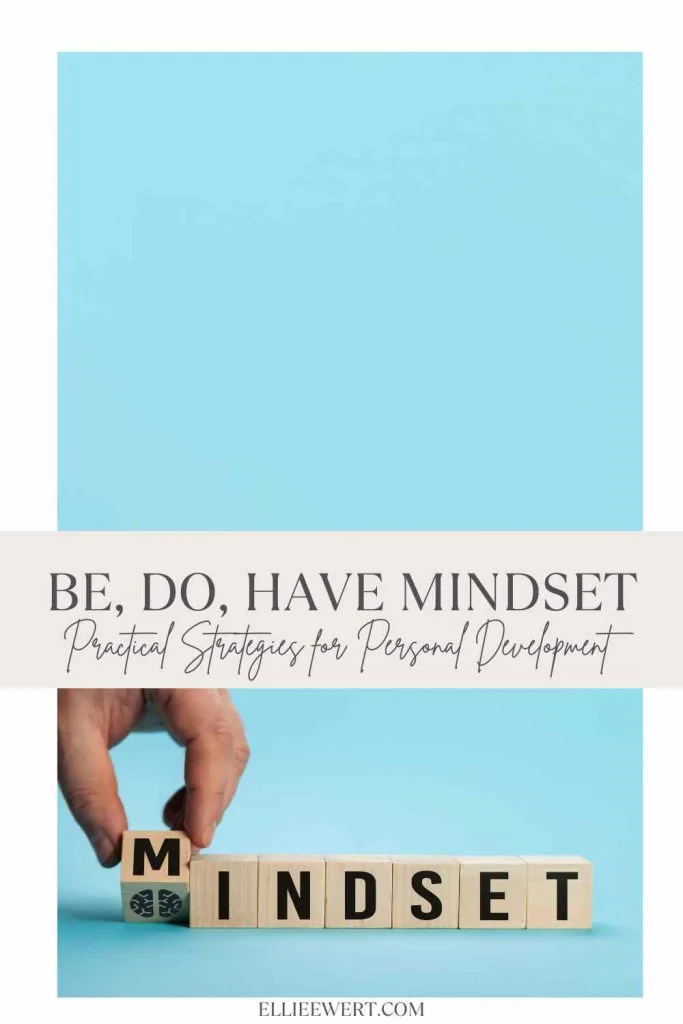Are you tired of feeling stuck and not making progress in your personal or professional life?
It’s time to shift your focus to the “be, do, have” mindset. By understanding this powerful concept, you can unlock the key to achieving your goals and living a more fulfilling life.

Be Do Have Explained
Core Concept
The Be-Do-Have mindset traces its roots to ancient philosophical teachings and has been embraced by various personal development experts.
This approach revolves around three key questions: Who do you need to be? What do you need to do? What will you have as a result?
The “Be” question focuses on one’s character, values, and identity, emphasizing the importance of inner qualities.
In contrast, the “Do” question pertains to actions and behaviors, while the “Have” question relates to outcomes and possessions.
The Be-Do-Have mentality prioritizes internal transformation before external achievements, highlighting the significance of character development.
Unlike other mentalities that solely emphasize actions or outcomes, this approach underscores the foundational aspect of being.
By focusing on embodying desired qualities first, individuals can authentically align their actions with their true selves, leading to more meaningful and sustainable results. It encourages individuals to lead by example, demonstrating the values they wish to see in their lives.
Significance
Embracing the Be-Do-Have mindset is pivotal for achieving long-term success and fulfillment. By internalizing desired qualities such as resilience, integrity, and compassion, individuals naturally exhibit behaviors conducive to goal attainment.
When individuals embody these traits, they exude confidence and authenticity, enhancing their effectiveness in pursuing objectives. This mindset fosters a holistic approach to success by emphasizing personal growth alongside external accomplishments.
The Be-Do-Have model is recommended for goal achievement due to its focus on intrinsic qualities that drive sustainable progress.
By prioritizing character development, individuals cultivate a solid foundation for enduring success rather than relying solely on fleeting external rewards.
Embodying the desired traits through the Be-Do-Have approach leads to a more fulfilling life by fostering genuine connections with oneself and others while promoting a sense of purpose beyond material gains.
Best Suited For
Individuals across various domains can benefit from adopting the Be-Do-Have mentality. Organization leaders seeking to inspire their teams can apply this mindset by embodying the values they wish to instill within their organizations.
Furthermore, those working on self-esteem can find value in this approach as it promotes self-awareness and authenticity.
Moreover, anyone seeking a positive outlook can enrich their lives through the Be-Do-Have mindset by prioritizing inner growth alongside external accomplishments.
The model encourages individuals to align their actions with their core values and beliefs, fostering a sense of fulfillment that transcends mere material gains.

Importance in Personal Development
Personal Growth
The Be-Do-Have mindset plays a pivotal role in personal growth by shaping individuals’ perspectives and actions. Embracing this mindset means focusing on being the person one aspires to be, taking relevant actions, and then reaping the rewards.
This approach contributes to personal growth by emphasizing the importance of internal development before external achievements. It encourages individuals to cultivate qualities such as resilience, determination, and adaptability, which are essential for personal growth.
The Be-Do-Have model is crucial in self-improvement as it underscores the significance of character development and skill-building. By prioritizing ‘being’ – embodying the desired traits and values, individuals can then engage in actions aligned with their aspirations.
This method fosters a continuous cycle of improvement where individuals constantly strive to enhance themselves through intentional actions and learning experiences. Consequently, this leads to a deeper understanding of oneself and an increased sense of self-awareness.
Adopting the Be-Do-Have approach often leads to profound self-discovery. By focusing on ‘being’, individuals delve into introspection and self-examination, gaining insights into their strengths, weaknesses, passions, and purpose.
This process enables them to align their actions with their authentic selves, leading to a more fulfilling life. Through this journey of self-discovery, individuals uncover hidden potentials and talents that contribute significantly to their personal growth.
Personal growth is intricately intertwined with the Be-Do-Have mentality because it emphasizes the significance of intrinsic qualities and proactive behaviors over external possessions or circumstances.
It prompts individuals to prioritize their inner development, fostering a strong foundation for sustainable personal growth.
By honing essential attributes such as perseverance, empathy, and integrity through ‘being’ and ‘doing’, individuals naturally attract opportunities and experiences that align with their personal growth journey.
Examples of how personal growth is linked to the Be-Do-Have concept include individuals who have transformed their lives by first embodying the traits they aspire to possess (‘being’), engaging in deliberate actions (‘doing’) that reflect these qualities, thereby attracting success, fulfillment, and meaningful relationships (‘having’).
For instance, many successful entrepreneurs attribute their achievements not only to specific actions but also to embodying qualities like resilience, innovation, and leadership before experiencing tangible success.
Success Pathways
The pathways to success through the Be-Do-Have mindset involve a strategic alignment of one’s mindset with intentional actions leading to desired outcomes.
This model outlines a clear pathway towards success by emphasizing the importance of cultivating the right mindset (‘be’), taking purposeful actions (‘do’), and ultimately achieving one’s goals (‘have’). By adhering to this framework, individuals pave the way for achieving success that is rooted in authenticity and purpose.
The Be-Do-Have model serves as a guide for achieving success by instilling a proactive approach towards goal attainment.
It emphasizes that success is not merely about obtaining material possessions or accolades; rather, it centers around becoming the kind of person who naturally attracts success through positive behaviors and attitudes (‘be’).
This approach empowers individuals to take ownership of their journey towards success by focusing on character development before external accomplishments.
Outlined steps involved in following the Be-Do-Have approach include first defining one’s core values, beliefs, and aspirations (‘be’), followed by deliberately taking action aligned with these principles (‘do’).
Finally, through consistent efforts based on these foundational elements comes the realization of goals or ambitions (‘have’). This sequential process serves as a roadmap for those seeking genuine success built on authenticity and purpose.
The Be-Do-Have mindset guides individuals towards success by fostering resilience, determination, and adaptability—qualities essential for navigating challenges while pursuing goals.
By embracing this mentality, individuals develop a resilient attitude that enables them to overcome obstacles while staying true to their values (‘be’), thus increasing their chances of achieving long-term success.
Successful individuals who have followed the Be-Do-Have model include renowned leaders who attribute their achievements not only to specific actions but also embodying qualities like integrity, vision, perseverance before attaining external success (‘have’).
Their journeys exemplify how aligning one’s mindset with intentional actions can lead to remarkable accomplishments rooted in authenticity.

Practical Strategies
Daily Application
The Be-Do-Have mindset can be applied in daily life by first setting clear intentions. Start by visualizing the desired outcome (Have), then identify the actions (Do) that will lead to this result, and finally embody the qualities and mindset (Be) needed to carry out these actions consistently.
To incorporate the Be-Do-Have approach daily, it’s essential to create a routine that reinforces this mentality. This could involve setting specific daily goals aligned with the desired outcomes, such as allocating time for learning new skills or engaging in activities that promote personal growth.
Consistency is crucial when applying the Be-Do-Have model. By consistently taking action towards one’s goals and embodying the desired qualities, individuals reinforce their commitment to achieving their aspirations. This consistency strengthens the connection between their actions and their envisioned outcomes.
Small daily actions play a significant role in reflecting the Be-Do-Have mindset. These actions, even if seemingly minor, contribute to the overall progress towards one’s goals.
For instance, spending a few minutes each day reading educational material or practicing a skill aligns with the “Do” aspect of the mindset and gradually leads to the desired “Have.”
Examples of daily routines that reflect the Be-Do-Have mindset include dedicating time each morning for meditation or visualization exercises to cultivate a positive and focused mindset (Be), followed by engaging in activities or tasks that directly contribute to personal or professional growth (Do), ultimately leading to an improved quality of life or career advancement (Have).
Decision Making
In decision-making, embracing the Be-Do-Have approach involves first envisioning the desired outcome (Have) resulting from a particular decision.
Then, identifying and committing to the necessary actions (Do) that will bring about this outcome is crucial. Finally, embodying the qualities and mindset (Be) required to follow through with these actions reinforces effective decision-making aligned with this mindset.
By adopting this approach, individuals can make decisions based on their long-term vision rather than short-term gains.
This allows for more strategic choices that align with their overarching goals and values. For example, when faced with career opportunities, individuals employing the Be-Do-Have mentality would consider how each option contributes to their long-term aspirations before making a decision.
Consistently applying this approach in decision-making fosters a sense of purpose and direction. It encourages individuals to prioritize decisions that are in line with their values and contribute positively to their personal or professional growth journey.
Techniques for Cultivation
Mindset Shifts
The be do have mindset requires specific mindset shifts to effectively cultivate it. Firstly, individuals need to shift from a fixed mindset to a growth mindset.
This involves believing that abilities and intelligence can be developed through dedication and hard work. Embracing a growth mindset encourages continuous learning and improvement, essential for the be do have approach.
Another crucial mindset shift is moving from a scarcity mentality to an abundance mentality. Shifting towards an abundance mindset allows individuals to focus on opportunities rather than limitations.
This shift enables them to see possibilities and solutions instead of dwelling on problems or lack, aligning perfectly with the be do have philosophy.
Moreover, adopting a positive outlook on life is vital for the be do have mindset. This involves cultivating optimism and resilience, enabling individuals to navigate challenges with a proactive and solution-oriented approach.
By maintaining a positive attitude, individuals can attract more positive experiences and outcomes in line with their desired be do have goals.
Habit Formation
To embody the be do have mindset effectively, habit formation plays a pivotal role. First and foremost, establishing a daily routine that aligns with the desired be do have outcomes is essential. Consistent daily habits create momentum towards achieving the envisioned lifestyle or goals.
Practicing visualization techniques can aid in habit formation for the be do have approach. Visualizing oneself already in possession of the desired attributes or accomplishments reinforces the subconscious mind, making it easier to adopt behaviors conducive to achieving those goals.
Furthermore, accountability partnerships or groups can significantly contribute to habit formation within the be do have framework.
Sharing progress, challenges, and successes with like-minded individuals creates a support system that fosters commitment and consistency in pursuing the intended be do have objectives.

Overcoming Limitations
Common Challenges
People often face limitations in various aspects of their lives. These challenges can manifest in different forms, such as lack of resources, skills, or opportunities.
Many individuals struggle with self-doubt and fear of failure, which can hinder their progress. External factors like societal expectations and financial constraints contribute to the feeling of being limited.
One common challenge is the mindset of scarcity, where individuals believe that there are not enough resources or opportunities available to them.
This can lead to a sense of hopelessness and resignation, making it difficult for people to strive for more. Another challenge is the fear of failure, which often stems from past experiences or societal pressure. This fear can prevent individuals from taking risks and exploring new possibilities.
Moreover, many people lack the necessary skills and knowledge to overcome their limitations. Whether it’s due to educational barriers or a lack of access to learning opportunities, this limitation can hold individuals back from reaching their full potential. Societal norms and expectations can create mental barriers that limit personal growth and development.
Solutions
To overcome these limitations, individuals can adopt a “be do have” mindset, focusing on who they need to be in order to do what is necessary to have what they desire.
By shifting their perspective from scarcity to abundance, individuals can start recognizing the resources and opportunities available to them. Embracing a growth mindset allows people to see failures as learning experiences rather than setbacks.
Another solution is building resilience through self-empowerment and positive affirmations. By cultivating a strong sense of self-belief and confidence, individuals can confront their fears and push past their comfort zones. Seeking mentorship and guidance from those who have overcome similar limitations can also provide valuable insights and support.
Furthermore, acquiring new skills through continuous learning and personal development programs can help break through barriers imposed by limited knowledge.
Taking proactive steps towards skill enhancement opens up new possibilities for growth and advancement. Challenging societal norms and redefining personal definitions of success can empower individuals to break free from mental constraints imposed by external influences.
Achieving Goals
Setting Objectives
Setting clear and specific goals is essential to the “be do have” mindset. When individuals define their desired outcomes, it becomes easier to align actions with their aspirations.
For instance, if someone aims to improve their physical fitness, setting a goal of exercising for 30 minutes daily can provide a clear target. This clarity enhances focus and motivation.
Aiming for realistic and attainable desires ensures that individuals don’t feel overwhelmed or discouraged. For example, if someone dreams of starting a business, they may set an initial objective of researching the market and creating a business plan.
By breaking down the larger dream into smaller, achievable steps, individuals can maintain momentum and avoid feeling daunted by the enormity of their ambitions.
Moreover, having access to resources that support the pursuit of these objectives is crucial. Whether it’s access to mentorship, educational materials, or financial support, ensuring availability of necessary resources can significantly impact one’s ability to achieve their goals.
Strategy Implementation
Once objectives are established, implementing a strategy becomes the next vital step in realizing those aspirations. Individuals can begin by outlining a clear plan of action that breaks down each objective into manageable tasks.
For instance, if the goal is to enhance professional skills, the strategy might involve identifying relevant courses or workshops for skill development.
In addition to planning, regular evaluation and adjustment of the strategy are important components of successful implementation.
By periodically assessing progress and making necessary adjustments, individuals can adapt to changing circumstances while staying on track towards their goals.
Furthermore, seeking support from others can greatly aid in executing strategies effectively.
This could involve joining communities or seeking guidance from mentors who have already achieved similar outcomes. Learning from others’ experiences can provide valuable insights and help refine one’s approach towards reaching their desired outcomes.

Model Applications
Coaching Use
Coaching, whether in sports or personal development, utilizes the be do have mindset to foster growth. Coaches encourage their clients to adopt this mindset to achieve their goals effectively. By emphasizing being (mindset), doing (actions), and having (results), individuals can develop a clear path to success.
Coaches guide their clients to first focus on being the person they want to become. This involves cultivating the right mindset, attitude, and beliefs that align with their desired outcomes. By instilling a positive and growth-oriented mindset, individuals can approach challenges with resilience and determination.
Next, the doing aspect comes into play. Coaches help individuals identify actionable steps aligned with their aspirations. By taking consistent and purposeful actions, individuals can make tangible progress towards their objectives. This includes setting specific goals, creating action plans, and implementing effective strategies.
Finally, the having component revolves around reaping the rewards of one’s efforts. Coaches assist their clients in visualizing and manifesting the outcomes they desire. This involves celebrating achievements, acknowledging progress, and embracing the results of their hard work.
Steps for Implementation
Initial Steps
When implementing the be do have mindset, the initial steps are crucial. Firstly, individuals need to assess their current mindset and identify areas where they can make improvements.
This involves reflecting on their thought patterns, behaviors, and habits to pinpoint areas that require change. Secondly, setting clear and achievable goals is essential. By defining what they want to achieve with the be do have approach, individuals can create a roadmap for their personal development.
Moreover, seeking out resources and support systems can significantly aid in adopting the be do have mindset.
This could involve reading books on personal development, attending workshops or seminars, or even seeking guidance from a mentor who has successfully implemented this mindset. Surrounding oneself with like-minded individuals who also embrace this philosophy can provide valuable encouragement and motivation.
Practicing gratitude and visualization techniques play a fundamental role in the initial steps of implementing the be do have mindset.
Expressing gratitude for what one already has fosters a positive outlook, while visualization helps individuals manifest their desired outcomes by envisioning themselves already possessing those achievements.
Lastly, it’s important to take consistent action towards personal growth. This involves incorporating daily habits that align with the be do have approach such as affirmations, mindfulness practices, and continuous learning through reading or listening to educational content.
Progress Monitoring
Monitoring progress is an integral part of embracing the be do have mindset. Regular self-assessment allows individuals to track their growth and make necessary adjustments along the way. Setting up a journaling practice where one records their thoughts, emotions, and achievements enables them to gain insights into their progress.
Furthermore, seeking feedback from mentors or peers can provide an external perspective on one’s growth journey. Constructive criticism and advice from those who have successfully implemented the be do have philosophy can offer valuable guidance for improvement.
Celebrating small victories is crucial in progress monitoring. Acknowledging and appreciating every milestone achieved reinforces a positive mindset and motivates individuals to continue striving towards their goals.
Moreover, revisiting and adjusting goals based on progress is essential in maintaining momentum. As individuals evolve through their personal growth journey with the be do have mindset, it’s important to reassess goals periodically to ensure they remain aligned with their aspirations and values.
Regularly engaging in self-reflection exercises such as meditation or introspective journal prompts aids in maintaining clarity of purpose while fostering resilience during challenging times.

Formula for Success
Key Components
The be do have mindset consists of several key components that are essential for achieving success. First, it involves cultivating a strong sense of self-awareness.
This means understanding one’s strengths, weaknesses, values, and goals. With this awareness, individuals can align their actions with their core beliefs and aspirations.
Second, the mindset emphasizes taking consistent and intentional action towards one’s objectives. This involves setting clear, achievable goals and persistently working towards them.
Third, it prioritizes the development of skills and knowledge relevant to one’s ambitions. Continuous learning and growth are integral to embodying the be do have mindset.
Moreover, the be do have mindset also encompasses the concept of resilience. It encourages individuals to embrace challenges as opportunities for growth rather than insurmountable obstacles.
Resilience enables people to bounce back from setbacks, learn from failures, and adapt to changing circumstances.
The mindset emphasizes the importance of building meaningful connections with others. Collaboration, networking, and seeking mentorship are crucial aspects of realizing one’s ambitions within this framework.
Starting with Be-Do-Have
Getting Started
To adopt a be-do-have mindset, one must first focus on being the person they aspire to be. This involves shaping one’s identity, values, and beliefs in alignment with their goals. For instance, if someone aims to become a successful entrepreneur, they should embody the traits of resilience, innovation, and leadership from the outset.
By internalizing these qualities, individuals can naturally gravitate towards actions that resonate with their desired identity. This might involve seeking out entrepreneurial opportunities, networking with like-minded individuals, or pursuing relevant education and experiences.
By consistently embodying the characteristics of a successful entrepreneur, individuals start to attract opportunities that align with their aspirations.
Moreover, maintaining clarity on personal values and long-term objectives is crucial when starting with a be-do-have mindset.
This clarity serves as a compass for decision-making and prioritization. For example, if someone values integrity and excellence in their professional life, they will naturally seek out opportunities and experiences that allow them to uphold these values.
Furthermore, setting specific goals based on the desired identity is essential for getting started with a be-do-have mindset.
These goals act as milestones that propel individuals towards their envisioned future. By breaking down larger aspirations into manageable objectives, individuals can create a clear roadmap for their personal and professional development.
Maintaining Momentum
Consistency is key to maintaining momentum when embracing the be-do-have approach. Individuals need to continuously reinforce their chosen identity through deliberate actions and habits.
By consistently exhibiting behaviors aligned with their desired persona, individuals reinforce this identity both internally and externally.
Surrounding oneself with a supportive community can significantly contribute to sustaining momentum in adopting a be-do-have mindset.
Engaging with mentors, peers, or groups that share similar values and ambitions provides encouragement and accountability. This support network can offer guidance during challenging times and celebrate achievements along the journey.
Moreover, reflecting on progress regularly helps individuals stay focused on their chosen path while making necessary adjustments along the way. By acknowledging accomplishments and learning from setbacks, individuals can refine their approach towards embodying their ideal self.
Final Remarks
Incorporating the be-do-have mindset into your life can be transformative. By focusing on who you need to be, what you need to do, and what you want to have, you can unlock your full potential and achieve your goals.
Embracing this approach empowers you to take control of your personal development, overcome limitations, and create a clear path toward success.
The practical strategies, real-life examples, and model applications provided offer a roadmap for implementing this mindset in various aspects of your life.
Now is the time to start applying the be-do-have mindset. Take the techniques and steps outlined here and begin incorporating them into your daily routine. As you cultivate this mindset, you’ll find yourself making significant strides in achieving your aspirations and creating the life you desire.
Frequently Asked Questions
What is the “Be-Do-Have” mindset?
The “Be-Do-Have” mindset is a concept that emphasizes being, doing, and having in a specific order. It suggests that one must first embody the qualities of who they want to become (be), take action aligned with those qualities (do), and then attain the desired outcomes (have).
Why is the “Be-Do-Have” mindset important in personal development?
Embracing the “Be-Do-Have” mindset fosters a proactive approach to personal growth. By focusing on internal qualities first, individuals can align their actions and goals with their true selves, leading to more authentic and sustainable personal development.
What are some practical strategies for cultivating the “Be-Do-Have” mindset?
Practical strategies for cultivating the “Be-Do-Have” mindset include self-reflection, goal-setting based on personal values, practicing mindfulness, embracing a growth mindset, and seeking role models who embody desired qualities.
Can you provide techniques for implementing the “Be-Do-Have” mindset in daily life?
Techniques for implementing the “Be-Do-Have” mindset include visualization exercises, affirmations aligned with desired traits, habit formation based on chosen behaviors, seeking feedback for continuous improvement, and consistent alignment of actions with values.
Are there real-life examples of individuals applying the “Be-Do-Have” mindset successfully?
Yes, many successful individuals attribute their achievements to adopting the “Be-Do-Have” approach. From entrepreneurs to athletes and artists, numerous people have demonstrated how aligning their being with their actions has led to remarkable accomplishments.


